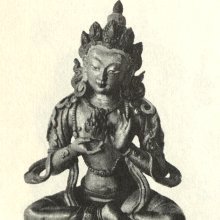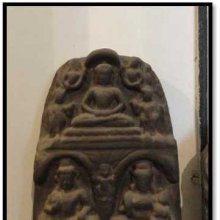Ratnamukuta, Ratnamukuṭa: 6 definitions
Introduction:
Ratnamukuta means something in Hinduism, Sanskrit. If you want to know the exact meaning, history, etymology or English translation of this term then check out the descriptions on this page. Add your comment or reference to a book if you want to contribute to this summary article.
Images (photo gallery)
In Hinduism
Purana and Itihasa (epic history)
Source: archive.org: Shiva Purana - English TranslationRatnamukuṭa (रत्नमुकुट) refers to “wearing a gem-set crown” and is used to describe Śiva, according to the Śivapurāṇa 2.3.46 (“The arrival of the bridegroom”).—Accordingly, as Brahmā narrated to Nārada: “Menā saw with pleasure lord Śiva, the bridegroom of Pārvatī, served by all the gods and who by that time had come there. Śiva had the complexion of the colour of the Campaka flower. He had only one face but retained the three eyes. The face was beaming with a simple smile. He was bedecked in gems and gold and wore a garland of Mālatī flowers. The gem-set crown (ratnamukuṭa) was lustrous. He wore brilliant necklaces. He was bedecked in bangles and bracelets of fine workmanship. [...]”.

The Purana (पुराण, purāṇas) refers to Sanskrit literature preserving ancient India’s vast cultural history, including historical legends, religious ceremonies, various arts and sciences. The eighteen mahapuranas total over 400,000 shlokas (metrical couplets) and date to at least several centuries BCE.
Pancaratra (worship of Nārāyaṇa)
Source: Shodhganga: Kasyapa Samhita—Text on Visha Chikitsa (p)Ratnamukuṭa (रत्नमुकुट) refers to a “crown made of (different) gems”, and is mentioned in the meditation on Garuḍa in the Tejomaṇḍala, according to the second chapter of the Kāśyapa Saṃhitā: an ancient Sanskrit text from the Pāñcarātra tradition dealing with both Tantra and Viṣacikitsā (Toxicology).—The Kāśyapasaṃhitā describes the different forms of Garuḍa in the five bhūta-maṇḍalas on which the aspirant has to meditate upon to cure the snake-bite victim from the poison which could have killed him. In the Tejo-maṇḍala, Garuḍa is meditated upon as one with tremendous speed and with the effulgence of the fire at the time of dissolution, clad in yellow and donninga a crown of different gems (citra-ratnamukuṭa), his hands adorned with the conch and the tarjanī-mudrā, adept in arresting poison

Pancaratra (पाञ्चरात्र, pāñcarātra) represents a tradition of Hinduism where Narayana is revered and worshipped. Closeley related to Vaishnavism, the Pancaratra literature includes various Agamas and tantras incorporating many Vaishnava philosophies.
Languages of India and abroad
Sanskrit dictionary
Source: Cologne Digital Sanskrit Dictionaries: Edgerton Buddhist Hybrid Sanskrit DictionaryRatnamukuṭa (रत्नमुकुट).—(compare °makuṭa), name of a Bodhisattva: Mahāvyutpatti 657.
Source: Cologne Digital Sanskrit Dictionaries: Monier-Williams Sanskrit-English DictionaryRatnamukuṭa (रत्नमुकुट):—[=ratna-mukuṭa] [from ratna] m. Name of a Bodhi-sattva, [Buddhist literature]
[Sanskrit to German]
Sanskrit, also spelled संस्कृतम् (saṃskṛtam), is an ancient language of India commonly seen as the grandmother of the Indo-European language family (even English!). Closely allied with Prakrit and Pali, Sanskrit is more exhaustive in both grammar and terms and has the most extensive collection of literature in the world, greatly surpassing its sister-languages Greek and Latin.
See also (Relevant definitions)
Partial matches: Ratna, Mukuta.
Full-text: Ratnavati.
Relevant text
Search found 2 books and stories containing Ratnamukuta, Ratnamukuṭa, Ratna-mukuta, Ratna-mukuṭa; (plurals include: Ratnamukutas, Ratnamukuṭas, mukutas, mukuṭas). You can also click to the full overview containing English textual excerpts. Below are direct links for the most relevant articles:
Jain Remains of Ancient Bengal (by Shubha Majumder)
Jain Tutelary Couple or Parents of the Tīrthaṅkaras < [Chapter 6 - Iconographic Study of Jaina Sculptural Remains]
Planatary Deities type of Śāntinātha Sculptures < [Chapter 6 - Iconographic Study of Jaina Sculptural Remains]
Images of Tīrthaṅkara Ajitanātha < [Chapter 6 - Iconographic Study of Jaina Sculptural Remains]
Maha Prajnaparamita Sastra (by Gelongma Karma Migme Chödrön)
Act 9.1: Description of the Ratnāvatī universe and the Buddha Ratnākara < [Chapter XV - The Arrival of the Bodhisattvas of the Ten Directions]
Act 10.8: The Sahā universe transforms into jewels < [Chapter XV - The Arrival of the Bodhisattvas of the Ten Directions]

